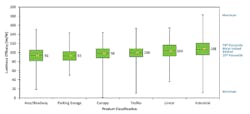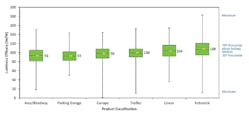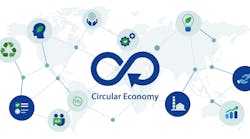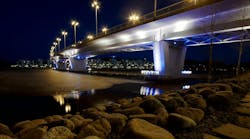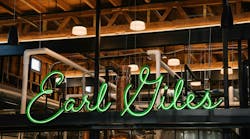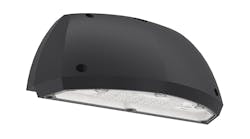LED-based fixtures are proving able replacements in outdoor lighting applications ranging to 100,000 lm while delivering benefits in energy efficiency and better beam control relative to HID lamps.
The US Department of Energy (DOE) has issued another Caliper report, in this case a Snapshot report on outdoor lighting based on data stored in the agency's Lighting Facts database. The report focuses on three categories of products including area/roadway/street light, parking garage, and canopy luminaires. The solid-state lighting (SSL) products are delivering tremendous energy efficiency advantages over legacy sources, and in particular the high-pressure sodium (HPS) lamps that have been the most broadly used technology in outdoor applications. Still, the outdoor products generally trail indoor LED luminaires slightly in terms of efficacy.
Interested in articles & announcements on outdoor lighting?
The DOE's Caliper Snapshot reports are based on data gathered in the Lighting Facts program — one of the original programs instigated to ensure lighting manufacturers were delivering on their published claims and specifications. Lighting Facts emerged originally back in 2009 and was most recently updated by the DOE in 2013 with changes in required testing procedures and new verification methodology. Most all reputable SSL manufacturers participate in Lighting Facts and submit specs for all new products into the database.
In the new report, the DOE said the full database includes a total of just under 50,000 products and the outdoor lighting products covered in the report make up 20% of those products. The report only considers integral luminaires and does not include retrofit kits, although the DOE noted that such kits are available in each of the three categories considered. The area category is by far the largest as it includes street and roadway lights, products such as wall packs, and outdoor parking lot luminaires that may or may not differ from street lights.
The Department of Energy's latest Snapshot report focuses on updates to LED outdoor lighting efficacy and additions to product lines with warmer CCTs.
The report documents that 46% of the products in the database exceed the efficacy requirements for listing on the DesignLights Consortium (DLC) Qualified Products List. Moreover, 10% of the products now qualify at the DLC Premium classification that varies between 115 lm/W and 120 lm/W based on lumen output. In the HPS case, only in the 1000W (around 100,000 lm) performance level would any legacy product meet DLC requirements and none would meet the Premium bar.
Still, the outdoor lighting products trail indoor products as mentioned before. Mean efficacy in the LED outdoor products tops out at 98% for canopy lights with the other categories each down at 93 lm/W. The DOE compared those numbers to troffer, linear, and industrial indoor products that hit 100, 104, and 108 lm/W, respectively.
The DOE suggested that the slightly lower efficacy in mean efficacy for outdoor products is related to the luminous intensity distributions or beam patterns required in the outdoor products. For background on beam patterns, see a relatively old feature article on the topic that is still very valid today. Most street- and parking-targeted luminaires use secondary total internal reflection (TIR) optics mounted on individual LEDs or small tightly-grouped arrays of LEDs to form the desired beam pattern that might be an elongated rectangle. Those optics presumably impact optical efficiency, which is one of the losses that is a component in measured efficacy.
Efficacy in general is on a steady but shallow ramp for all of the luminaire types covered. Still, many things have changed significantly in the past few years. We covered another Snapshot report on outdoor lighting back in 2013. At that time, we reported that there were very few LED luminaires capable of delivering the light output necessary to supplant 400W HPS lamps. The latest report clearly reveals that LEDs are capable to the 1000W level.
There are also major changes in the spread of color temperature or CCT offered in the database. The calls from some activists and municipalities for warmer CCTs has clearly led manufacturers to add such products to their portfolios. We have covered the CCT debate multiple times, most recently in reference to the American Medical Association recommending warmer CCTs at 3000K or warmer.
The DOE said 12% of area products, 6% of parking garage products, and 14% of canopy products in the database have a CCT of 3000K or lower. We noted in our coverage of a prior report that most all of the products in the database fell in the 4000K–6000K range. Certainly 4000K remains dominant. The DOE said 37% of the area lights are at 4000K today.
The report does document the efficacy penalty of warmer CCTs. In area lighting luminaires, including street lights, efficacy drops by 2.7 lm/W per 1000K change in CCT. The difference between a 6500K and 3000K luminaire could approach 10 lm/W in some cases.
We continue to write that light intensity and optical control is more important than CCT, but many citizens and activists don't separately consider the two issues and characterize whiter light as being brighter. In reality, many installed lights are simply just operated too brightly. Indeed, the DOE report stated that in some cases LED fixtures may not produce quite as many lumens as HPS sources, but the lumens are more effectively controlled and distributed. And we may still learn as fact that humans see better under cooler lights.
The Snapshot report has a number of more interesting facts and figures. You can access the entire report at the DOE website.
